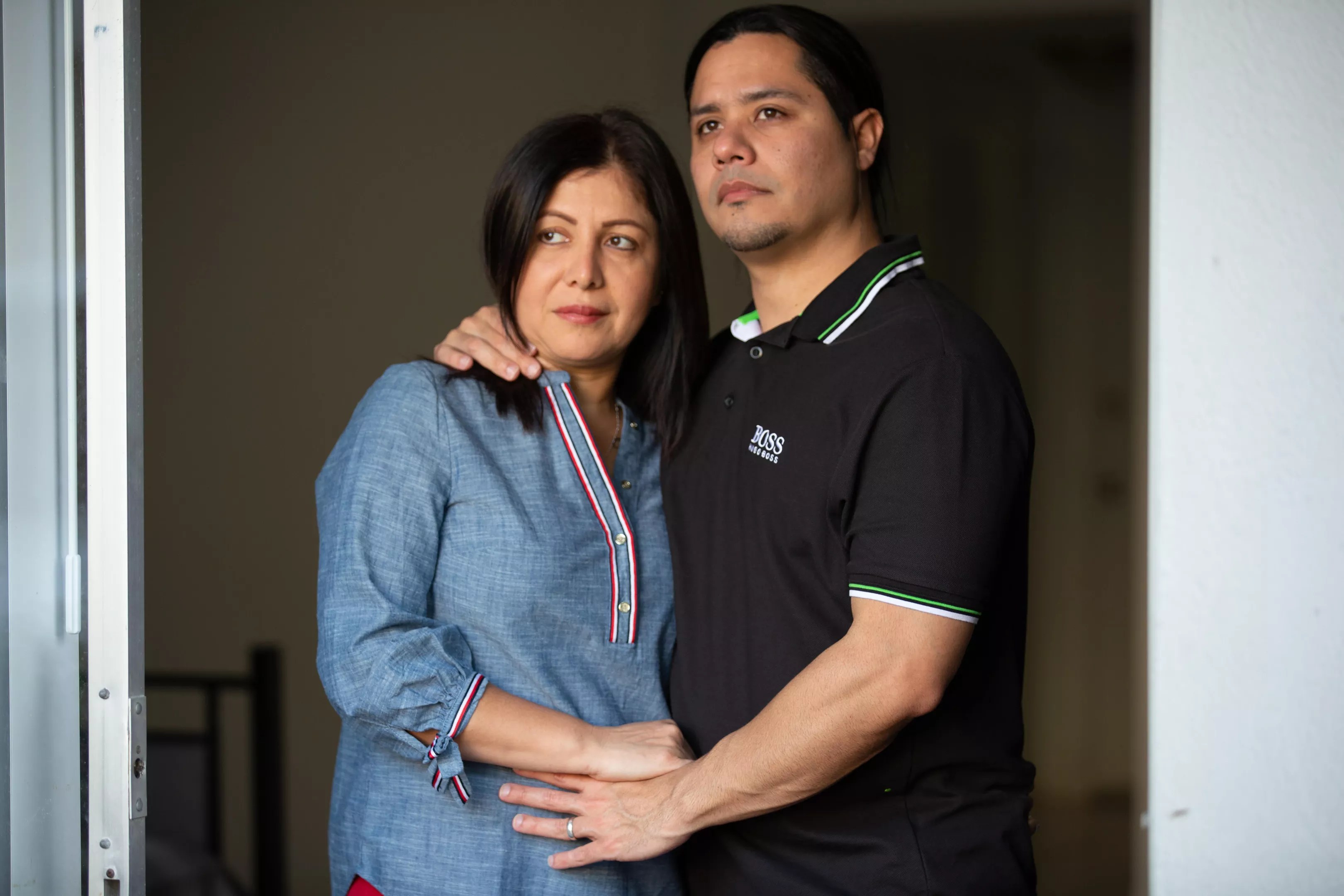
Photo by Jorge Martinez

Audio By Carbonatix
It was as if the bridge appeared out of nowhere.
Carlos Badillo had driven past Florida International University before, but on March 15, 2018, he noticed something he hadn’t seen just a week earlier. It was a little before 2 p.m., and he was driving east on Tamiami Trail with his wife, Martha Plaza Cevallos. Up ahead, a 174-foot bridge had been erected in front of the Modesto A. Maidique Campus.
“How strange,” Badillo told his wife. “How can they build something so quickly?”
Plaza, who was applying her makeup in the passenger seat, cracked a joke.
This year, make your gift count –
Invest in local news that matters.
Our work is funded by readers like you who make voluntary gifts because they value our work and want to see it continue. Make a contribution today to help us reach our $30,000 goal!
“If this were in one of our countries, those bridges last two or three years,” Plaza, a native of Ecuador, told her Venezuelan husband.
The traffic light was red by the time they reached the intersection. Still curious about how they’d accomplished such a feat, Badillo stared up at the construction workers on the bridge. The light turned green and he took his foot off the brake. In that moment, everything came crashing down.
The tremor of 950 tons of falling concrete shook them in a violent and unrecognizable way. As their bodies coursed with adrenaline, their minds
Outside the car, it became clearer what had happened. The hood of their Kia Optima was smashed beneath the impossibly new bridge. Other vehicles had been completely buried. Good Samaritans slammed their cars into
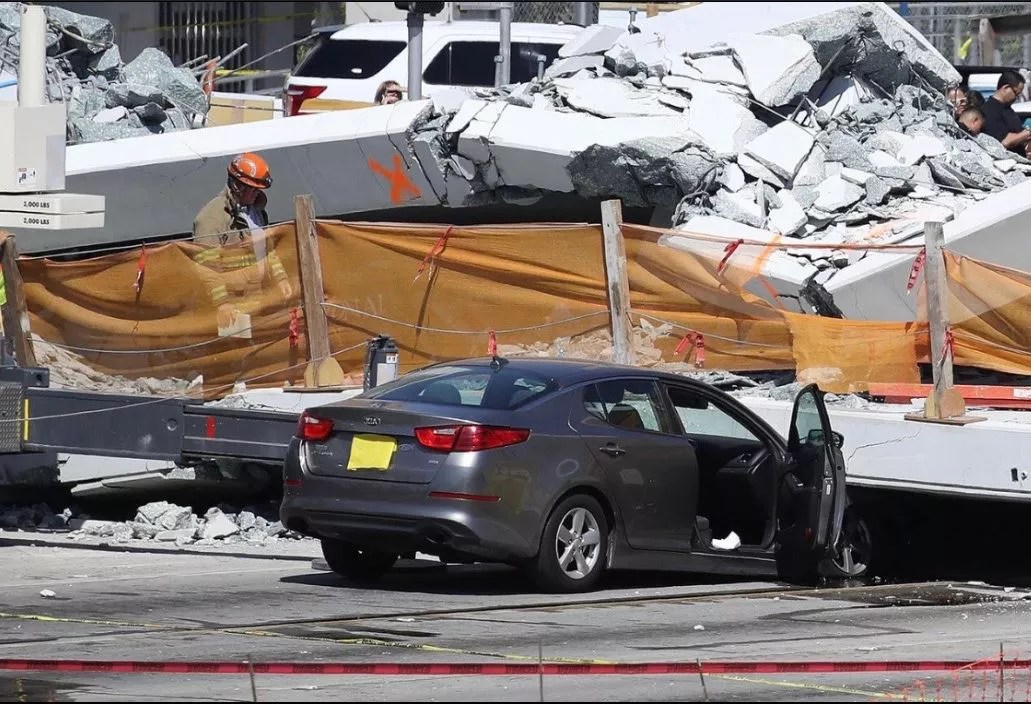
Carlos Badillo and Martha Plaza Cevallos were inside a Kia Optima when FIU’s new pedestrian bridge came crashing down.
Courtesy of Andres Beregovich
“We started seeing the bodies of the workers being taken out covered in blood, and I got lost,” Plaza says today in Spanish. “I don’t know anything else.”
The bridge collapse that afternoon injured eight people and killed six. Had Badillo and Plaza been one second faster or three feet farther underneath the structure, the death toll might have been eight. By the grace of God, the luck of the draw, or however you measure that kind of inexplicable blessing, their lives were spared. But their reality was changed forever.
“I’m not the same as I was before,” says Badillo, 35.
“You want to start a normal life,” 43-year-old Plaza explains, “but you can’t.”
One year later, the two are still being treated by teams of physical therapists and psychologists. They’ve lost their jobs at a valet parking company because they’re too terrified to drive on a regular basis. They’re suing the companies that built the bridge while defending themselves in three countersuits from insurance companies that don’t want to pay out.
“You want to start a normal life, but you can’t.”
Emotionally, the past 12 months have been “a mix of everything,” Plaza says.
“Grateful to God because you’re alive to tell the story.
“Frustrated a bit because you’ve lost a year where you could’ve done so many things.
“Faithful that God is just and that, at some moment, there will be a solution.
“And worried because bills don’t wait and you have to keep going.”
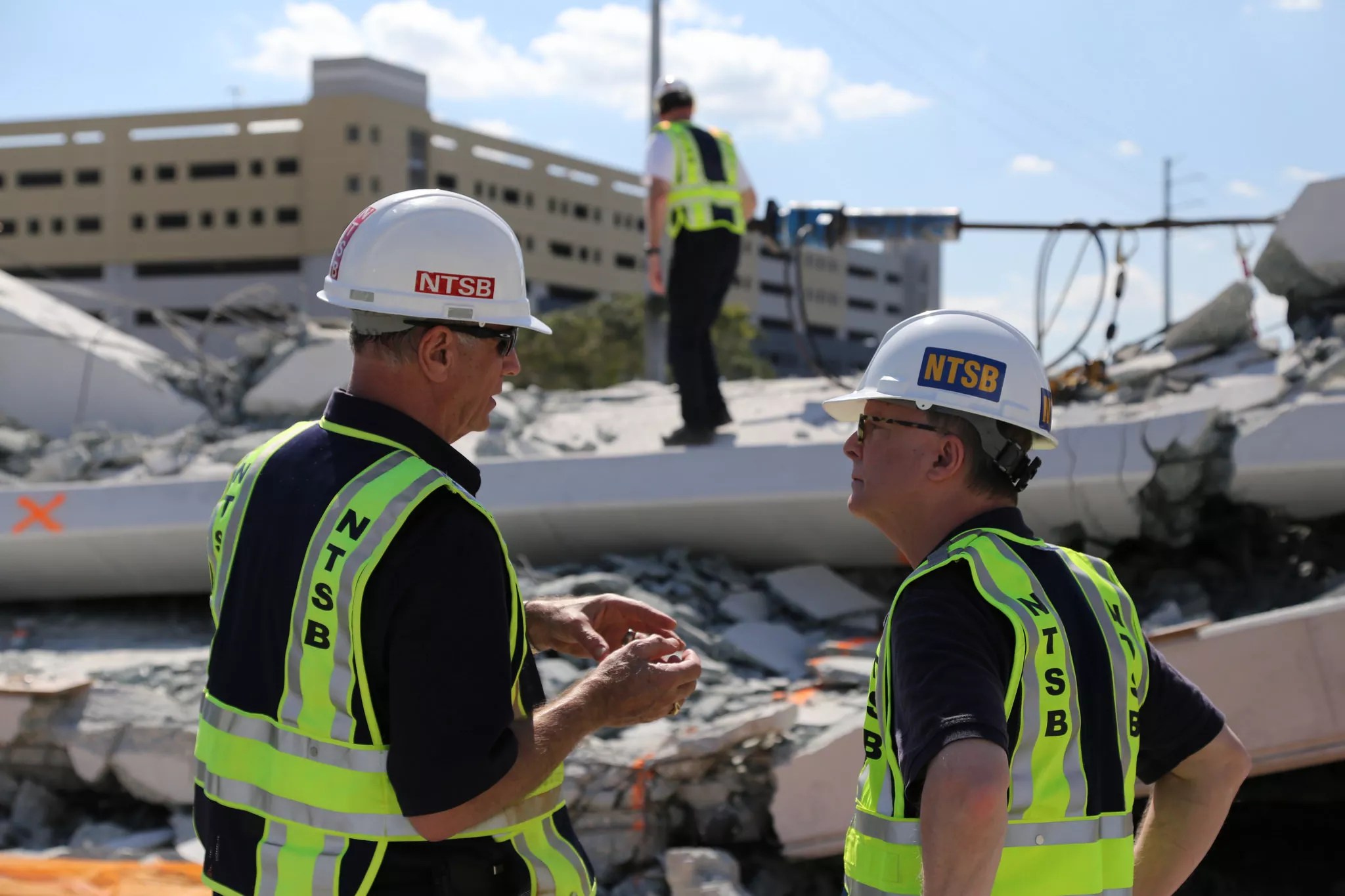
A member of the National Transportation Safety Board investigates the collapse of a bridge on the FIU campus.
Photo by Chris O
A Signature Bridge
The pedestrian bridge at FIU was supposed to save lives.
From 2005 to 2015, the university nearly doubled in size, with the student body swelling to more than 54,000. Almost 4,000 lived in the nearby city of Sweetwater, and on a daily basis, those students crossed eight lanes of traffic on Tamiami Trail to reach the Modesto A. Maidique Campus. FIU had been applying for grants to build an elevated pedestrian bridge since 2010, but it wasn’t until 2013 that the university was finally awarded enough money to make it happen – $11.4 million from the U.S. Department of Transportation.
Plans for the bridge began early, but as with any ambitious infrastructure project, construction was far from quick. In August 2017, at least a year before the pedestrian overpass at Tamiami Trail and SW 109th Avenue was scheduled to be completed, 18-year-old freshman Alexis Dale was struck and killed by a car while crossing the intersection. Sweetwater Mayor Orlando Lopez called for the bridge, which was part of a larger development project, to be expedited.
“We’ve told the developer to speed up the bridge and worry about the streets and plaza
As the project neared completion, university officials touted the bridge as a way to keep students out of danger.
“FIU is about building bridges and student safety. This project accomplishes our mission beautifully,” FIU President Mark B. Rosenberg said in a news release days before the bridge crumbled.
“The rapid development… likely caused the project to be rushed, and this resulted in the bridge’s collapse.”
After the collapse, attorney Alan Goldfarb began representing the family of Alexa Duran, an 18-year-old FIU student who was killed as a result. Because he had already been working on a case against the university regarding Dale’s death in 2017, Goldfarb had access to documents and emails about the bridge that raised questions for him about how quickly the project had sped along.
“It is our opinion that the rapid development used by the bridge companies likely caused the project to be rushed, and this resulted in the bridge’s collapse,” Goldfarb says on his law firm’s website.
A probe into the collapse is ongoing, but the latest report from the National Transportation Safety Board, issued in November, says design errors likely led to cracking in the bridge. One area of interest to investigators is a technique used to build the structure, known as accelerated bridge construction. To minimize traffic delays and risks to workers, the pedestrian bridge was assembled nearby and then swung into place March 10, 2018 – five days before it collapsed. That’s why Badillo hadn’t seen the bridge just a week earlier.
Badillo and Plaza have since sued the four companies that designed and built the bridge – MCM (formerly known as Munilla Construction Management); FIGG Bridge Group; Bolton, Perez & Associates; and Louis Berger. In the initial complaint, the couple accuses the companies of performing “in a negligent, careless, and reckless manner in willful and wanton disregard for the life and safety of the public,” particularly by allowing crews to work on the bridge while traffic still flowed below.
The companies have asked the court to dismiss the case, but it remains pending in Miami-Dade County. New Times asked the four defendants for comment. MCM was the only company to respond.
“Our prayers continue to be with the families of those we lost and everyone that was impacted by the bridge failure last year. We mourn their losses along with our community,” Mike Hernandez, a spokesman for MCM, said in an email. “MCM continues to cooperate with the National Transportation Safety Board as it investigates this tragic accident.” Federal investigators examine the debris from the collapse of a bridge on FIU Photo by Chris O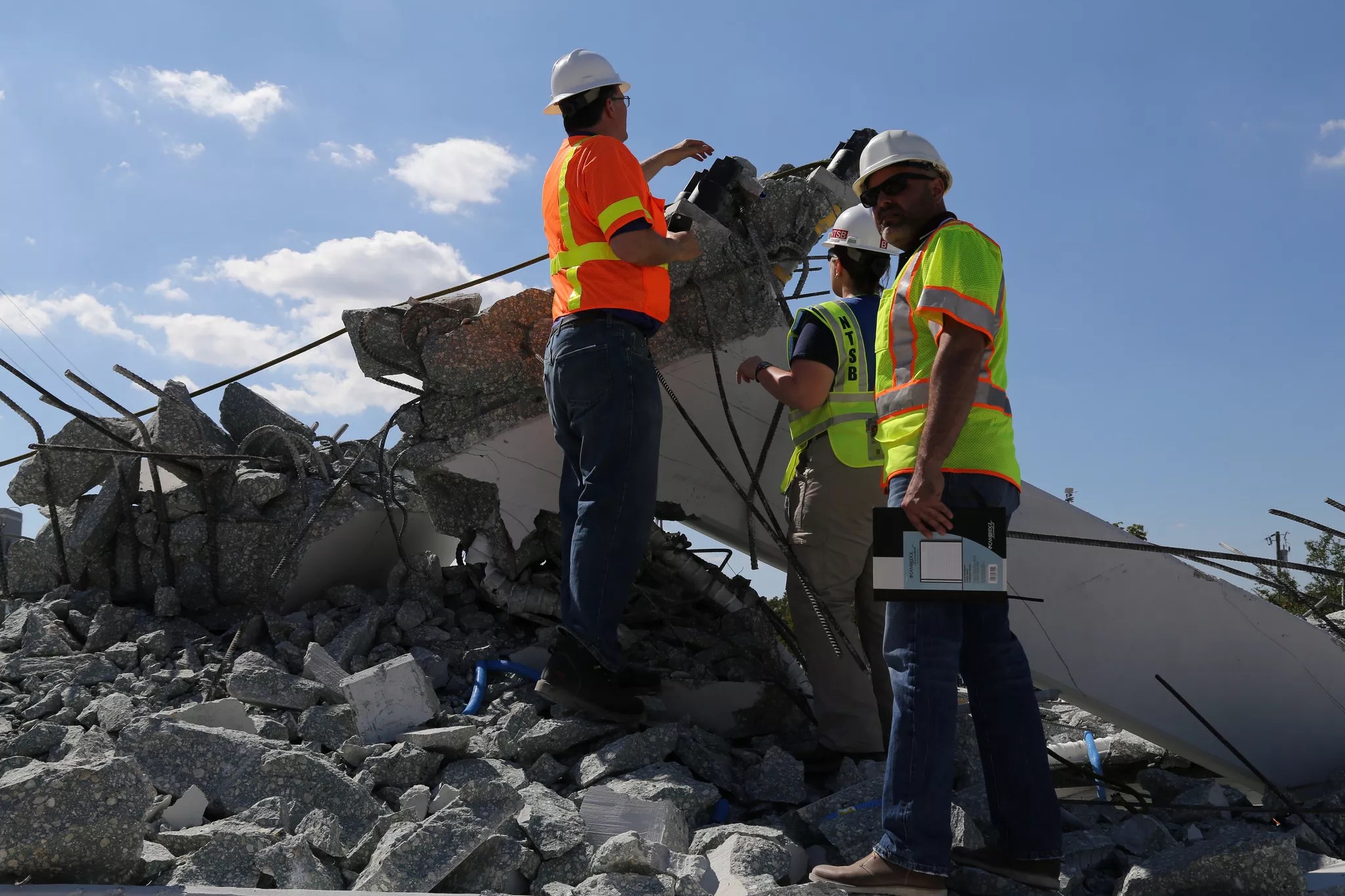
In total, at least 15 lawsuits have been filed against more than two dozen bridge contractors in Miami-Dade Circuit Court. For the meantime, the cases have been consolidated so the attorneys can jointly request documents and interview key players. The first mediation was held in November but reached no conclusion. A second mediation has been set for March 20.
Complicating the legal matters, MCM recently filed for Chapter 11 bankruptcy. As a result of the bankruptcy proceedings, the damages for claims against MCM – which is facing 18 lawsuits related to the bridge project – could be capped at $54 million.
Andres Beregovich, the attorney representing Badillo and Plaza, says that amount might not go far enough to compensate all of the victims.
“The Munilla Construction Management design-build team, in my opinion, was definitely underfunded for the type of work that they were doing,” he says. “It’s a company doing design-build of a very complicated new design… and they have a very limited insurance policy, which is definitely financially irresponsible.”
In addition to the lawsuit he’s filed against MCM and the other contractors, Beregovich is also defending Badillo and Plaza from three countersuits filed by insurance companies that argue the couple’s coverage doesn’t apply in the case of the FIU bridge collapse.
“To me, it’s absolutely disgusting,” Beregovich says. “These are very complicated insurance issues where everyone is just pointing the finger at each other.”
Over the past year, Badillo and Plaza have racked up hundreds of thousands of dollars in unpaid medical bills. The two have been diagnosed with posttraumatic stress disorder and haven’t been able to work. Though they were fortunate enough to escape death, their ongoing suffering makes their case expensive to settle.
“They’re alive, so they’re still suffering, and these companies, the only thing they care about is their bottom line,” Beregovich says. “The defendants have a great opportunity right now to stop [Badillo and Plaza’s] suffering right now. And the ball’s in their court right now as to whether they want to do it the hard way or the easy way.”
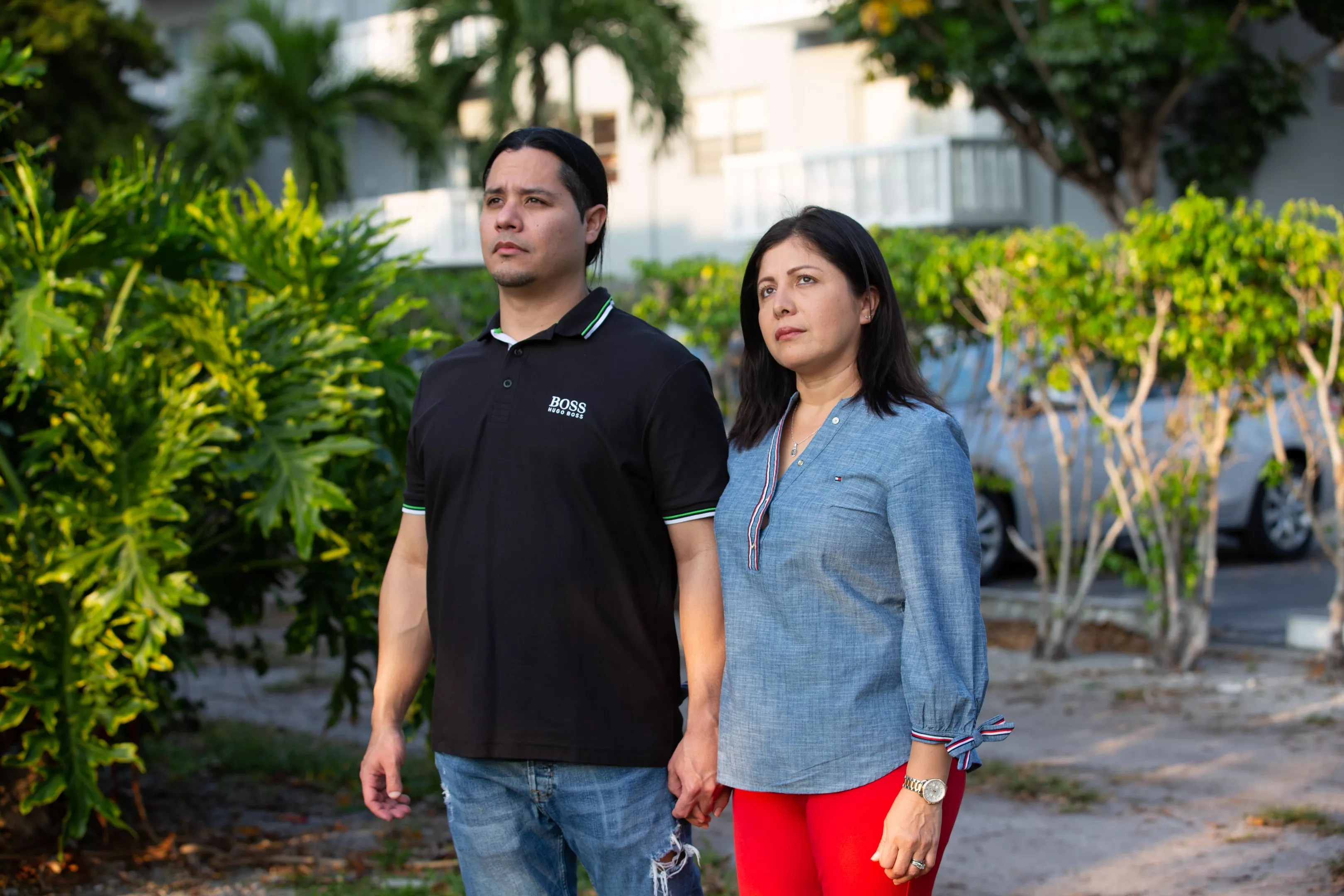
Carlos Badillo and Martha Plaza Cevallos
Photo by Jorge Martinez
The Aftermath
When she arrived at the hospital via ambulance the afternoon of the bridge collapse, Plaza was separated from her husband. She wasn’t sure if Badillo was OK – she wasn’t even sure how she herself was doing. Doctors at Kendall Regional Medical Center began poking and prodding her and eventually ordered an MRI to check for internal bleeding.
“I started screaming because they were those machines where they enclose you,” Plaza says. “I felt like I was dying.”
She returned to a hospital room where, just a few hours later, another bridge victim – construction worker Navaro Brown – died next to her.
“It was horrible to see their families crying, to see the doctors running,” Plaza says. “That made you become even more panicked and feel more terror.”
After two days, Plaza and Badillo were discharged, but memories from the collapse and the hospital haunted them at home.
“It’s been a complicated year,” Plaza says. “It hasn’t been easy.”
Getting into a car still requires summoning a tremendous amount of courage. A month or so after the accident, the two were on their way to the doctor when they caught a red light underneath a bridge in Kendall. Plaza burst into tears and began shaking. Since then, she has refused to stop beneath overpasses.
“I stay back even if the cars honk at me,” she says. “I don’t care.”
In South Florida, where daily living almost necessitates getting in a car, their fear has kept them isolated at home. With only a few relatives living in the States, they hoped to lean on friends for support, but many seemed interested only in the future payout.
“People who truly love you won’t just ask you, ‘How much money are you going to get?'” Badillo says. “They’ll say, ‘Did you eat today?’ ‘Are you OK?’ ‘Did you take your medicine?'”
Since then, she has refused to stop beneath overpasses. “I stay back even if the cars honk at me.”
The two are still being treated by doctors and physical therapists who have agreed to take payment at a later date. Badillo, whose legs were injured in the collapse, was on crutches for almost two months afterward and still struggles to walk normally. Doctors say he might need back surgery. Plaza suffers from pain in her neck, back, and hip and has developed kidney problems from the steroids she was prescribed. In late January, she miscarried a baby, something she believes could have been the effect of her medication or the radiation she was exposed to during x-rays.
At the time of the accident, Badillo and Plaza had been married only three months. As they each recovered from their own physical ailments and internalized trauma, they began picking fights and arguing with each other.
“We had a lot of psychological pain – that all affected our relationship as a couple,” Badillo says. “Nowadays, thank God, we’re more aligned. Our psychologists have helped us a lot.”
With a bit more distance from the time of the collapse, the two now see they can understand each other like no one else ever could.
“Really, the ones who know the internal process are her and
For Plaza, the accident felt like a sign that her life had a purpose she had yet to fulfill. After the collapse, she got a tattoo to remind herself of the significance of all she’d experienced: the phrase “One day at a time,” flanked by a dove, on her left collarbone.
“I felt that represented my life from now on,” she says. “I don’t think about what’ll come tomorrow, but what I can do today.”
Assistant culture editor Celia Almeida contributed reporting and translating for this story.